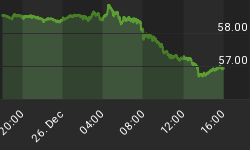All the rain in the world (and it seems like we got, in fact, all the rain in the world) was unable to long dampen spirits of equity traders. Although the market started off with a small slither lower, the upward momentum remains in place although to be fair the last couple of days' worth of flirtation with the January highs of the S&P hasn't exactly blown away the skeptics. Stocks today closed roughly unchanged after a soft open. June 10y Note futures gained about 2 ticks in a quiet session.
It appears as if the March-Lack-of-Madness has already hit the bond market (under the conservation-of-madness principle, NCAA March Madness seems to be mirrored by lethargic trading every year - at least in the fixed-income world), but there is a lot on tap this week that could change that. Not standing a chance, though, were today's slightly stronger-than-expected Empire State Manufacturing Report (showing that last month's jump in the index wasn't entirely fluke) and slightly weaker-than-expected Industrial Production and Capacity Utilization numbers (overall strength in the numbers masked the fact that most of that strength was from utilities output - the cold weather giveth, and the cold weather taketh away).
I like looking at seasonally-adjusted electricity use. Although over a long-term chart it muddies the question of productivity improvements, over the short-term it's pretty interesting. It's hard to make a lot more output without some more input. And here the picture is decidedly less rosy than the Industrial Production data. I wonder whether this indicates a movement of the production away from products that require high energy input (autos? raw steel?) to less-energy-intensive stuff. I don't know the answer, but I find the divergence of this series from the Industrial Production index series to be curious.

Going Green The Hard Way!
Tomorrow's release of Housing Starts (Consensus: 565k versus 591k last month) has a somewhat better chance of rocking the boat, but only if those Starts convincingly break above 600k - where they haven't been for more than a year. The chart below (Source: Census Bureau) illustrates that even an annual pace of 600,000 units started...about three months' worth at the peak...wouldn't exactly, um, 'break new ground' so to speak.

Wouldn't 600k be really great? No?
Although such a figure wouldn't exactly trigger paroxysms of joy, I think it would have an impact as the "second derivative" crowd would be excited at the improvement. Face it, the level isn't going to be exciting. And the rate of change (first derivative) over the last couple of years is pretty ugly; over the last year or so it has gotten flat. A 600k would excite people who put a lot of importance on the mere transition from declining, to flat, to rising (even though, within the usual variance of the data, it would be hard to make such a pronouncement).
More important - and at least the source of more nervousness - will be the Fed's post-meeting announcement late in the day. Here, again, we have a Fed in a transition from very easy policy to something close to neutral to something tighter; at least, that is what we are supposed to believe. While some of the more vocal hawks on the Fed are supposedly agitating for tighter policy, I think last month's snugging of the discount rate was a bone thrown to them to keep them at bay for a bit. I doubt very seriously that the Committee feels like experimenting with a dramatic new statement, especially since there is already a pending experiment at the end of this month when the Desk stops buying mortgages. I don't expect anything of significance out of this meeting (for example, a change in the statement to suggest that the time of low rates is drawing to a close), but even minor changes in the statement will likely lead to some post-release volatility.
The Fed's first move toward tightness, when it does come, will be a good test to see if the conditions in the equity market are bubbly or just reflecting improved conditions over the last year. A bubbly market, such as the one we saw in the late 1990s, tends to take news that the Fed is hiking rates as "evidence that the economy is strong," which is absurdly inconsistent with the notion that equities are near fair value considering the level of interest rates - that sort of absurd inconsistency would itself be an indication of bubbly conditions. A more rational response to the eventual hiking of rates would be a decline in the equity markets of a few days to a few weeks, as some marginal owners of equities shift to interest rate vehicles that are suddenly more attractive.
As I say, that musing is likely to be out-of-place on Tuesday, as I don't expect the Fed to do anything significant. (It may take a little while to figure out that it isn't significant, however!).
















